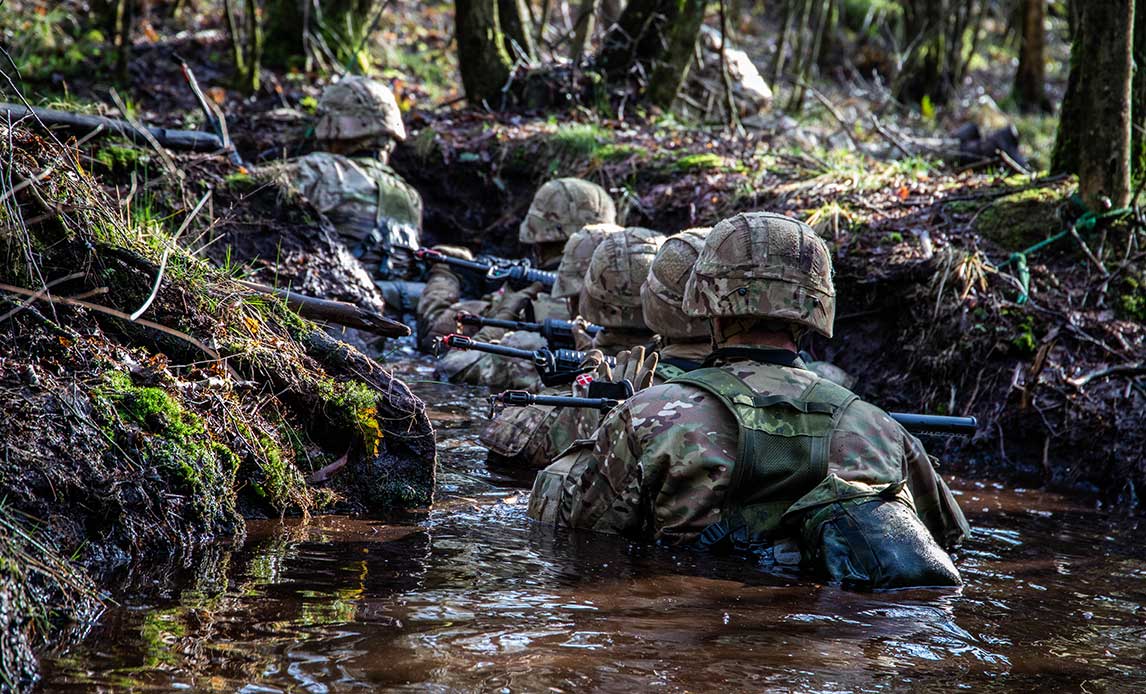News
Agreement for Danish Defence 2018 - 2023
With a new six year Defence Agreement from 2018 to 2023 the Parties agree to substantially increase defence spending.

The number of conscripts is increased and the length of service is extended for parts of the conscripts. Conscripts in the Air Force on field exercise. Photographer: Iben Valery
Global threats are more serious than at any other time since the fall of the Berlin Wall. Threats can occur anywhere in the world, both far from Denmark and in our region. Danish Defence enforces the sovereignty of the Kingdom of Denmark and ensures the continued existence, integrity and security of the nation. A robust Danish defence and preparedness is the prerequisite for a safe society.
With a new six year Defence Agreement from 2018 to 2023 the Parties agree to substantially increase defence spending. By 2023 the annual budget increase will reach DKK 4.8 billion. There will be more operational units and troops and a more agile, less top heavy organisational structure. The national emergency preparedness will be significantly strengthened with more people and more equipment and cyber security will be enhanced. The substantial increase will strengthen Defence in the following areas:
Denmark’s contributions to NATO’s collective deterrence and defence will be increased with investments in new capacities, i.a. a brigade, air defence missiles for our frigates, a 50 percent increase in special operations patrol units and a capacity for anti-submarine warfare. Together with NATO, the Danish Armed Forces must have sufficient potency and robustness to deter others from attacking our allies and ourselves. The new Defence Agreement will secure considerably increase Danish contributions to the world’s strongest defence alliance.
Enhanced Defence capacity to contribute to international operations and stabilisation efforts by 50 percent with an increase of budget reserves for international operations to DKK 750 million by 2023. The Peace and Stabilisation Fund will also be increased to DKK 150 million by the end of the agreement period, corresponding to a 75 percent increase. There will greater robustness and flexibility as individual units from the deployable brigade can also deploy separately for international operations. A light infantry battalion will be established, for national or international use, and there will be investments in extra crews for Defence transportation aircraft.
Defence contributions to national security is strengthened with increased support for the police, i.a. with protection and guard units and with personnel on high readiness who can support in case of terrorist attacks etc. National military service and mobilisation will be strengthened so more troops can mobilised in the event of a crisis or war. A mobilisation company will be established for each of the three combat battalions in the brigade. The number of conscripts will increase with 500, where some will have longer national service than today, and national service will be targeted towards national challenges. Enrolment and conscription initiatives will be enhanced to provide as many volunteers as possible for national service. The national emergency preparedness will be strengthened with extra conscripts and equipment. The strong engagement in the Arctic will continue with new initiatives such as conscription testing, a new civilian emergency education in Greenland with focus on preparedness and finally local employment opportunities with Danish Defence Arctic Command.
Cyber protection will be significantly strengthened with the new Defence Agreement in the coming Defence Agreement period. Sensor networks will be developed, a new cyber situation centre will be established and the Centre for Cyber Security will strengthen analytical and advisory competencies. An allocation of DKK 500 million in reserve will be dedicated for the handling of future cyber challenges alongside a strengthening of research and education efforts, bringing Denmark to the forefront within this field.
Initiatives to veterans will be strengthened with the Agreement, with an improved selection process of soldiers, research and improved compensation schemes.
- Danish Defence Agreement 2018-2023
- Supplemental agreement for the Danish Defence 2018-2023
- Strengthened Danish Defence - presentation
- Press Release 2018-01-28
Prior Danish Defence Agreements
With the Danish Defence Agreement 2013-2017, a broad agreement was reached regarding the organisation of the defence for the period 2013-2017, thus replacing the present agreement. The agreement was entered into by the parties behind the present Danish Defence Agreement 2010-2014.
Danish Defence Agreement 2013-2017 (pdf)
The agreement was made between seven of the eight political parties represented in the Danish parliament on June 24, 2009. The agreement describes that the development of the armed forces is to be continued along the lines set down in the 2005-2009 defence agreement.
- Defence Agreement 2010-2014 (English version)